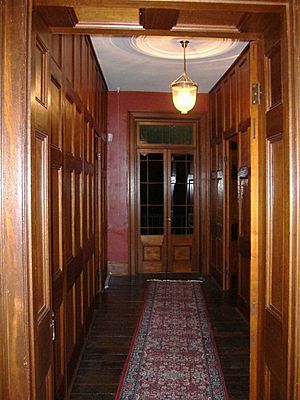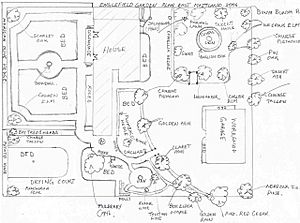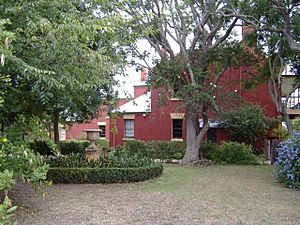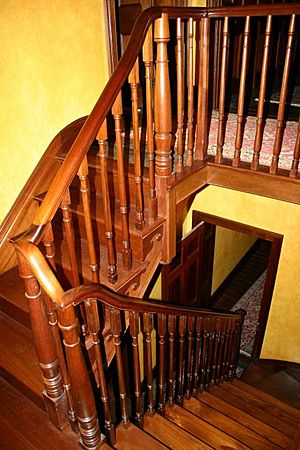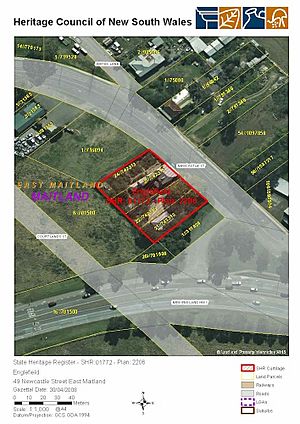Englefield, East Maitland facts for kids
Quick facts for kids Englefield |
|
|---|---|
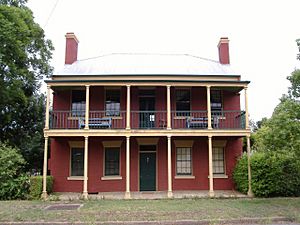 |
|
| Location | 49 Newcastle Street, East Maitland, City of Maitland, New South Wales, Australia |
| Built | 1837–1837 |
| Owner | Paul & Di Scherr |
| Official name: Englefield; Black Horse Inn | |
| Type | state heritage (built) |
| Designated | 30 April 2008 |
| Reference no. | 1772 |
| Type | House |
| Category | Residential buildings (private) |
| Lua error in Module:Location_map at line 420: attempt to index field 'wikibase' (a nil value). | |
Englefield is a historic house in East Maitland, Australia. It was built in 1837 and first served as a home. Later, from 1845 to 1878, it became a popular place called the Black Horse Inn. Today, it is a private home again.
Englefield is very important to the history of New South Wales. It is listed on the New South Wales State Heritage Register because of its age, unique style, and interesting past.
Contents
A Look Back: Englefield's Story
Englefield was built around 1837 by a man named John Smith. He was known as "Gentleman" John Smith. The land where the house stands was given to him by Governor Lachlan Macquarie way back in 1818.
John Smith's Journey
John Smith had a very interesting life. He was a former convict who came to Australia. After facing some challenges, he became a successful businessman. He was made Chief Constable in Newcastle and was allowed to own land. In 1823, he opened the first licensed inn in the Hunter Valley, called the Ship Inn. He also started a store and traded goods between Newcastle and Sydney.
John Smith grew his farm at Wallis Creek, which is now Maitland. He had many acres of land, horses, cattle, and sheep. He was a very successful farmer and businessman.
From Home to Inn
Around 1837, John Smith ordered special stone window sills, which are still part of Englefield today. The house was quite grand for its time. It was close to his flour mill and workers' homes, so he might have lived there.
In 1843, John Smith sold the property to Henry Adams, who was an innkeeper. In 1845, Adams moved his Black Horse Inn to this building. The house was changed a bit to work better as an inn. It stayed an inn until 1878, when Adams' sons turned it back into a private home. They were the first to call it "Englefield."
Exciting Horse Races
In 1856, a private racetrack was set up behind the house. The very first horse races in East Maitland were held there on Queen Victoria's birthday!
During the 1870s, when William Miles leased the inn, the Black Horse Inn Races became a big local event. People would gather to celebrate special days, like the "Anniversary of the Colony." The local newspaper, the Maitland Mercury, even wrote about it. They mentioned a special Irish stew called "kale cannon" being cooked in the inn's kitchen.
Later Years and Restoration
In 1901, a famous architectural firm, John W. Pender, worked on restoring the property. The Hickling family, who were hay farmers, owned Englefield from 1910 until 1968. After that, the house fell into disrepair for a while.
In 1986, Peter Gibbs bought Englefield. He worked for twenty years to restore the house to its original 1837 look. He also made changes to make it suitable for modern living. He even built a workshop to restore old Australian furniture. The garden was also rebuilt around some old trees and a plan from the 1920s. The garden was so beautiful that it was opened to the public in 1996 and 2006.
In 2005, the Governor of New South Wales, Marie Bashir, visited Englefield. After all the restoration work, the house and gardens were officially listed on the State Heritage Register in 2008.
What Englefield Looks Like
The House's Design
Englefield is a two-storey house with a classic Georgian style. It has a veranda with slender columns on both levels and sandstone paving on the ground floor. The roof is made of iron, but the original shingle roof is still underneath! The walls are very thick, about 35 centimeters (14 inches), and are made of old bricks held together with a special mortar.
Inside, you'll find beautiful cedar doors and fireplaces. There are seven bedrooms, including two attic rooms that are still very original. On the first floor, there's a large room at the front that can be divided into smaller spaces using special cedar panels. This was a common feature in grand homes of that time.
The house also has a cellar and an old kitchen that might even be older than the main house, built around 1826. This kitchen has a wood-fired bread oven with its original handmade door! Many of the original ceilings are still there, with beautiful decorative plaster designs. An interesting fact is that the front of the house is built at a slight angle to the street. This might be because the kitchen was built first, at a right angle to an older dirt road.
Gardens and Grounds
Englefield sits on four plots of land. Since 1986, a colonial-style garden has been rebuilt here. It includes old trees like jacarandas from the 1940s and a mulberry tree that's over 100 years old. The garden design loosely follows an old plan from the 1920s.
Most of the plants chosen for the garden were known to grow in Australian gardens before 1850. Instead of large lawns, there are "cottage beds" which were easier to care for. Paths made of gravel, stone, or brick connect different areas. There's an orchard with a winding gravel path and azaleas. One part of the orchard even has a stone "folly" (a decorative building that looks like a ruin) to mark where an old stable used to be.
There's also a drying court and a kitchen garden, which is now a herb and strawberry patch. This leads to a formal garden with a sundial in the middle. The hedges are made of African olive trees, a common type of colonial hedging. The garden is being updated with old European rose varieties.
Sadly, no outbuildings survived a flood in 1955. However, a workshop was built in 1987 by the current owner, designed to fit in with the historic style.
Condition and Changes
Englefield has been beautifully restored and is in excellent condition. It still has many of its original features.
Over the years, Englefield has had some changes:
- Around 1843: When it became the Black Horse Inn, some parts were changed. For example, a wall was removed to create larger rooms, and the staircase landing was altered.
- 1878: When it became a private home again, some windows were changed, and a new veranda was added. The roof shingles were covered with iron.
- 1901: More restoration work was done, including the veranda.
- 1986 - 2006: Peter Gibbs oversaw a major restoration. The original 1837 features, like the Georgian veranda and staircase, were repaired. The gardens were rebuilt, and a workshop was added. Modern kitchens and bathrooms were installed while keeping the historical feel.
Why Englefield is Important
Englefield is a very special place for many reasons:
- Old and Unique: It's a rare example of a colonial Georgian house built in 1837. It looks like an Irish farmhouse and still has many original parts, including its old kitchen and bread oven from around 1826.
- Part of History: It's one of several important old houses in East Maitland, showing how the area developed.
- Inn History: Its time as the Black Horse Inn is important to the history of inns along the Newcastle-Maitland road. The famous horse races held there add to its story.
- Connected to Key People: It's linked to John Smith, a former convict who became a very successful businessman in the Hunter Valley. It's also connected to Governors Lachlan Macquarie and Sir Richard Bourke, and architect John W. Pender.
- Architectural Beauty: Englefield is a beautiful example of a late Colonial period Georgian house. Its design, windows, doors, and veranda columns are very well-preserved.
- Shows Early Life: The house helps us understand how early settlers lived, cooked, slept, and entertained. We can see the materials, colors, and building styles from that time.
- Rare Example: It's a rare surviving example of a colonial house that also served as an inn, with many original features.
Englefield is important because it shows us the history of New South Wales, from early settlement and the success of people like John Smith, to the changing uses of buildings over time.


